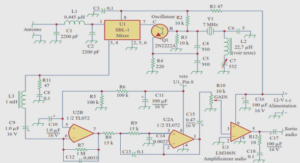Mesure de spectre et de SERN bande Ka en environnement contrôlé
NRCS Measurement
Characterization of the Incident Electromagnetic Field
The incident electric field on the illuminated patch has been characterized in the anecho€ıc chamber of the ONERA by measuring the complex field scattered by small corner reflectors placed at successive locations inside the illumination window and located at approximately 1.15 m from the aperture plane of the antenna. Figure 4 shows the normalized power of the electric field on a flat surface for a corner reflector with an edge 8 cm long. The maximum field is shifted by about 10 cm off the center of the disk. This is probably due to a slight misalignment of the radioelectric axis of the antenna. Cuts of the incident power in different directions show that it can be roughly approximated by a Gaussian illumination window with 80 mm standard deviation. Note that a Gaussian beam with large footprint with respect to the radar wavelength is known [see, e.g., Soriano et al., 2002] to be equivalent (within an overall coefficient of normalization) to a uniform illumination in terms of NRCS, that is, there is no angular distortion of the angular scattering diagram.
Measurement of the Backscattering Coefficient
A specific procedure has been developed to retrieve the absolute value of the NRCS from the time series of the recorded reflection coefficient. As the target is a fluctuating scene, the time duration for a given Figure 3. Side view of wind wavefields observed in the large wind-wave tank at 28 m fetch for a wind speed of (a) 2 m/s, (b) 3 m/s, and (c) 8 m/s. The wind blows from the right to the left. Journal of Geophysical Research: Oceans 10.1002/2014JC010338 BOISOT ET AL. KA-BAND WIND-WAVE TANK STUDY 4 measurement must be much shorter than the characteristic time of wave motions in order to consider the scene as static.
Emission and reception of a continuous electromagnetic wave are done through the S11 port of the VNA. If B is the intermediate frequency (IF) filter width, then the time measurement duration is of order of 1=B. An IF filter of 10 kHz thus corresponds to a duration of approximately 0.1 ms, during which it is reasonable to assume that the scene is static. The NRCS, denoted r 0 , is proportional to the intensity of the incoherent electromagnetic backscattered field, that is, the variance of the total field. This quantity is estimated from N successive measurements in time, assuming that the water surface roughness at each time corresponds to an independent realization of the same random process. This is actually true if the time lag is of the order of magnitude of a few seconds, that is, much larger than the period of dominant waves.






